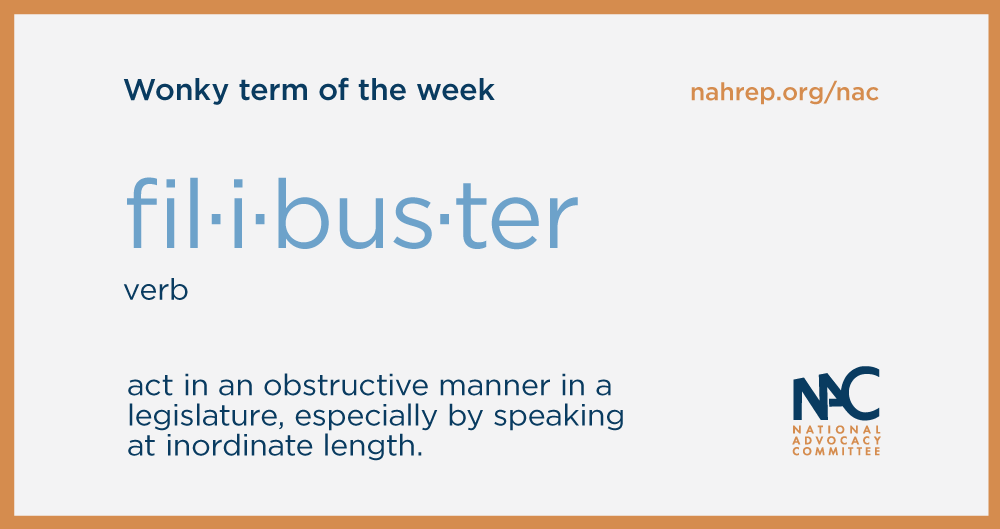NAC Blog: Fill to Bust
Celebrating NAHREP familia, cultura, politics, and grassroots action
June 17, 2021
Qué onda mi gente?!
Raise your hand if you hear people talk policy and you zone out mostly because they keep using strange words that you don’t understand?
I’m guilty of talking in “GovTalk” sometimes. I spent over a decade in Washington D.C., a town where people talk in acronyms. Before NAHREP, I spent 6 years working at the Consumer Financial Protection Bureau (CFPB), where it was seen as perfectly normal to say something like, “Since the HMDA working group finalized the ANPRM, there’s an OPM meeting at the EEOB to discuss collaboration between FHFA and the CFPB. Make sure you bring the RESPA proposal!” Como dice mi mama, “Apenas se puede creer!”
Well, here’s another one of those wonky terms that, if you watch the news, has been talked about a lot lately: the filibuster.
You might be asking, what the heck is the filibuster? Very simple: Es una locura!

Ok so let’s break this down into English (and even some Spanglish). I would focus on the FILL and the BUST part of the word. It basically means: Senators use the filibuster to FILL the time with locura, in order to BUST the bill.
Passing a bill in the Senate 101
First, let’s handle the basics. There are 100 U.S. Senators, with a current even split between Democrats and Republicans. The two don’t play nice with one another and Senators usually just vote with their party on any given bill. Here’s the catch: 60 votes are required to pass most legislation through the Senate, meaning you would need around 10 Senators from the opposite party to vote with you. That’s almost as likely as tacos being served without salsa, or arroz sin candules, or worse: a NAHREP event without music.
But, even in the case that 10 Senators were to vote with the opposing party, the minority party has a powerful and ridiculous tool at their disposal: the filibuster. They can talk and talk and talk, and talk some more, in order to prevent a bill from being voted on. And this, familia, is why Washington gets so little done.
Why this matters:
- Do you care about passing immigration reform?
- What about fixing our housing inventory crisis?
- How about just stuff simply getting “done”?
If the answer is yes, you care about the filibuster. If you want things to stay exactly the same, well… then you don’t want changes to the filibuster.
So next time you hear the word filibuster, think about this: it’s one of the reasons why Washington is broken.
You don’t believe me? I’ll leave you with some famous filibusters in history:
SENATORS FILLING TIME WITH LOCURA TO BUST A BILL
- The Pee Bucket Filibuster: A fulanito that went by Senator Strom Thurmond wins the award for the longest filibuster by speaking on the Senate floor for 24 hours and 18 minutes trying to block the Civil Rights Act in 1954. Imagínate? To prepare for his marathon speech, he took steam baths to sweat out all excess fluids so he wouldn’t have to go to the bathroom while “filibustering” and then had an intern stand by with a pee bucket just in case. I’m not making this up.
- Better than a Cooking Show Filibuster: This prize goes to Senator Huey Long from Louisiana, who in 1935 spoke for 15.5 hours reading everything from Shakespeare to recipes for fried oysters and pot stickers. He had to go the restroom at 4:00AM and that’s when the Senators passed the bill. You snooze you lose. He should have learned from Senator Thurmond.
- Seuss Filibuster: Senator Ted Cruz read “Green Eggs and Ham” by Dr. Seuss in 2013 in order to block Obamacare.
- Medicine for those with Insomnia Filibuster: Senator Alfonse D’Amato nearly broke Thurmond’s record while stalling a military appropriations bill in 1986. When he ran out of things to say during his 23-hour speech, he read out loud from the DC phone book.
Well there you have it mi gente, the wonky policy word of the week. Stay tuned for more next time.
Un abrazo.

About Noerena Limón
Noerena Limón is NAHREP’s Executive Vice President of Public Policy and Industry Relations. Noerena heads the organization’s policy and advocacy efforts on issues ranging from homeownership, housing inventory, credit access and immigration.
Prior to joining NAHREP, Noerena spent six years at the Consumer Financial Protection Bureau (CFPB) and served as a political appointee under President Obama in the White House Office of Political Affairs.



